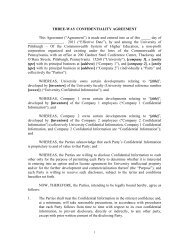The Pitt Innovator's Guide to Technology Commercialization
The Pitt Innovator's Guide to Technology Commercialization
The Pitt Innovator's Guide to Technology Commercialization
Create successful ePaper yourself
Turn your PDF publications into a flip-book with our unique Google optimized e-Paper software.
<strong>The</strong> <strong>Technology</strong><br />
Transfer CoMMITTee<br />
WWhen you submit your invention<br />
disclosure <strong>to</strong> OTM for commercial consideration,<br />
it goes before the University’s<br />
<strong>Technology</strong> Transfer Committee (TTC)<br />
for review. This peer-review committee,<br />
made up of University administra<strong>to</strong>rs<br />
and faculty members, meets monthly<br />
<strong>to</strong> determine the commercial merits<br />
of the submitted invention disclosures<br />
and decides in which innovations the<br />
University should invest its limited time,<br />
money, and other resources. In general,<br />
the committee his<strong>to</strong>rically has approved<br />
for commercialization an estimated<br />
55 percent of all those submitted <strong>to</strong><br />
OTM in a given year.<br />
TTC typically considers three main<br />
criteria in determining an innovation’s<br />
commercial merit:<br />
Is your idea protectable? <strong>The</strong><br />
committee will assess whether your idea<br />
holds <strong>to</strong> the legal definition of invention,<br />
including whether it is new, useful,<br />
and non-obvious. <strong>The</strong> U.S. Patent and<br />
Trademark Office won’t even consider<br />
your idea for patenting if it doesn’t meet<br />
that standard. And since most commercial<br />
partners won’t consider licensing<br />
your innovation without some kind of<br />
exclusive rights that come with patent or<br />
copyright protection, the University will<br />
pursue commercialization only when it<br />
can protect that exclusivity—and defend<br />
it when necessary in court.<br />
As part of this assessment, OTM will<br />
investigate all issues that emerge from<br />
an invention disclosure that could hinder<br />
intellectual property rights, such as the<br />
existence of restrictive corporate-sponsored<br />
research, or the use of outside<br />
materials <strong>to</strong> which the University does<br />
not have the intellectual property rights.<br />
A patent search might also turn up prior<br />
art that could undermine the seeming<br />
novelty of your idea.<br />
In addition, TTC often will enlist the help<br />
of a peer reviewer <strong>to</strong> assess technical<br />
issues related <strong>to</strong> your innovation.<br />
Is the patent protection on your<br />
idea enforceable? While your idea<br />
might merit patent protection according<br />
<strong>to</strong> patenting standards, a patent holds<br />
little value if you can’t defend it against<br />
those who copy your idea, or infringe<br />
on your exclusive rights. Indeed, just<br />
because your idea might be protected<br />
under patent law doesn’t guarantee that<br />
it will be protected in the court of law.<br />
Consider the following example of a<br />
real patent filed for a technique that<br />
transforms a common laser pointer<br />
in<strong>to</strong> an exercise device and method<br />
for cats (see page 20). If you have ever<br />
<strong>to</strong>rmented your feline in this manner for<br />
amusement, you’ve technically violated<br />
the patent holder’s exclusive rights. But<br />
try enforcing such patent rights against<br />
anyone who has ever used a laser<br />
pointer in this manner. You’ll find that<br />
defending such a patent would prove<br />
nearly impossible. So the University<br />
takes such enforceability in<strong>to</strong> serious<br />
consideration.<br />
18












